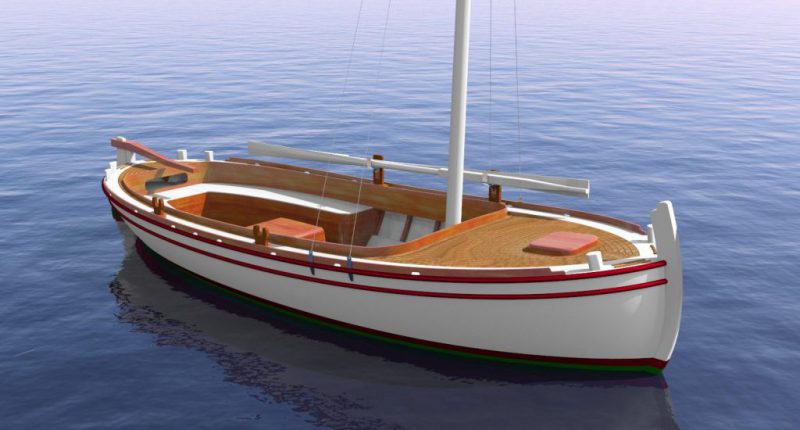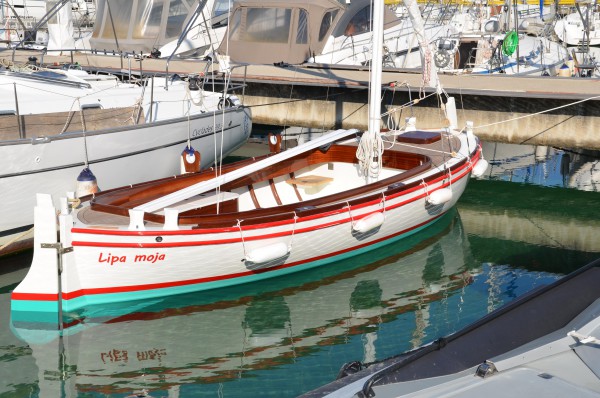Projects: Building an 18th century gajeta – Part 1
Part 1: Design and lofting
When naval architect Srdan Dakovic was recruited to combine traditional wooden boatbuilding with modern technology, he designed a Croatian gajeta to be cut by CNC and bonded entirely with WEST SYSTEM epoxy.


From 3D concept to hand-built reality. The completed gajeta takes part in the annual regatta, and – as the old sailors would say – has a real bone in her teeth.
The gajeta is a sub-type of a falkusa, a small coastal fishing boat developed in Croatia during the 18thcentury and now something of a maritime icon. Betina, near the town of Murter, has a long tradition of building a particular type of gajeta, with a canoe stern and latin-style sails. The design is celebrated with a competitive sailing festival every year but the skills that were used to make these attractive boats are steadily declining.
This is when a leading shipyard in the area decided to show that traditional skills can be meshed seamlessly with modern technology to keep the skill sets alive. They proved it by building a historic vessel for entry into the annual gajeta festival. Tech-savvy boat designer Srdan Dakovic found himself at the cutting edge in every sense of the word and sent this remarkable story to Epoxycraft.
Merging the centuries
“The Betina Shipyard is located in a traditional boatbuilding area where local craftsmen still build wooden boats using time honoured techniques,” Srdan explained. “Unfortunately, these days there are less and less people involved in this type of boatbuilding, since there are fewer buyers for these products, but luckily the traditional craftsmanship still exists. Some years ago, the management of the 200-year-old Betina Shipyard, the biggest in the area, decided to acquire a large CNC (computer numerical control) machine. Their intention was to use CNC to precisely cut the new planks needed for the wooden boats being refitted in the yard and it proved particularly useful for teak decks. Besides the obvious applications of CNC, management wanted to demonstrate to the local boatbuilding community what could be done with modern technology. The best way to make the point was to build a local boat for entry into the festival. The wooden components would be cut with CNC and then assembled entirely with WEST SYSTEM epoxy.”

The boat would be sealed inside and out with several layers of biaxial cloth saturated with WEST SYSTEM epoxy. This would completely waterproof the hull and form a solid base on which to build a high gloss yacht finish in two-pack polyurethane paint.
As a qualified naval architect with particular experience in sailboat design, Srdan was recruited to assist with the project.
“I was hired to design the boat and make a complete 3D model so it could be used for further development by the Betina Shipyard,” he said. “The concept was a traditionally-styled boat that will be faster and lighter than the competition and so outperform them at the annual festival.”
For Srdan, this meant building the entire structure out of precisely-cut planks, all held together purely with WEST SYSTEM epoxy. He intended to eliminate every single screw or metal fastening throughout the structure.
“It should also be best looking gajeta in the area, and sport a yachting paint finish,” he said. “Judging from result I think we achieved our goals.”
Here is the first phase of the build process, the lofting and frames, starting with the computer design:




The entire boat was designed using 3D modelling, as seen in these pictures. The beauty of this type of process is that the measurements can be transferred from the programme into a set of cutting plans, with software optimising the cuts to minimise wastage.

The next task was to create a jig. This would have to be strong enough to support the weight of the upturned 7-metre hull as it was assembled onto its frames. Here is the completed jig, made from pine and well braced so as to keep its shape.

Frame supports were placed equally along the top of the jig and secured with brackets. These would help top create the ultimate shape in the first stage of the build.

The frames start to go in. These are made from relatively cheap 25mm exterior ply and are screwed into the cross beams at the base and held equidistant with a longitudinal brace at the top. The CNC machine cut them all with total precision.

Stringers are used to finalise the hull shape. Here craftsmen at Batina Shipyard are bending long strips of timber around the last frame to meet the curved former for the bow. From now on, the rest of the frames and timbers will be laminated into CNC cut guides, or cut from solid timber.
Completing the upturned hull using WEST SYSTEM epoxy and some clever use of lamination and formers.
Read part 2 of the ‘Building an 18th-century gajeta’ series.



